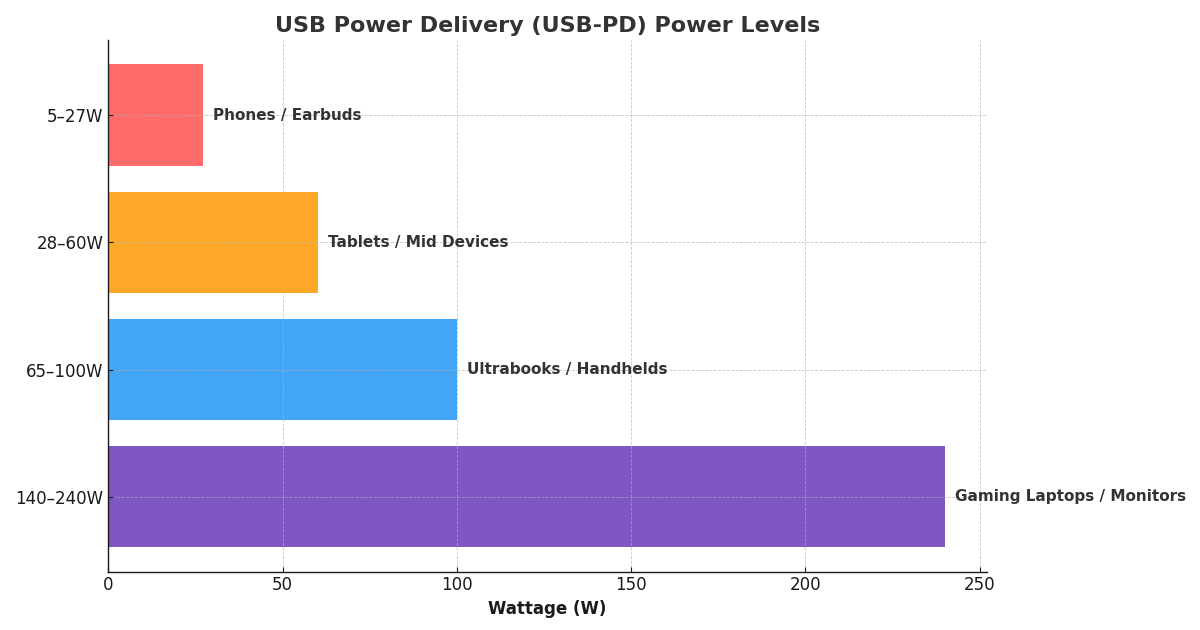What Is USB-PD? Explanation + Charts
USB Power Delivery (USB-PD) turns USB-C into a universal, negotiated power system for everything from earbuds to gaming laptops.

If you’ve bought a phone, laptop, or charger in the last few years, you’ve seen the label USB-C with PD. It’s more than just marketing. USB Power Delivery (USB-PD) is the technology that turned USB-C from a simple data connector into a universal power system that can charge everything from earbuds to gaming laptops — and soon, even power tools.
The first thing to understand is that USB-PD isn’t “just faster charging.” It’s a negotiated power standard. The device and charger talk to each other to decide the safest and most efficient voltage and current. No guessing, no over-voltage hacks, and no melting cables. They agree on a profile — 5V, 9V, 15V, 20V, or higher with the new Extended Power Range — and only then does the charger deliver the power.
Who came up with USB-PD?
Look to the USB Implementers Forum (USB-IF), the group responsible for USB standards since the 1990s. Around 2010, it was clear the industry needed a smarter approach. Smartphones were drawing more power, tablets were rising, and laptops still relied on proprietary chargers. Companies including Intel, Apple, HP, Microsoft, and Texas Instruments were early voices pushing for a unified, smart power spec.
The USB-IF published USB Power Delivery 1.0 in 2012, but adoption was slow — mainly because micro-USB couldn’t handle the new requirements. When USB-C launched in 2014, everything changed. Apple jumped first, shipping USB-C on the 12-inch MacBook in 2015 with USB-PD as its only charging method. Google followed with Chromebooks. From there, adoption accelerated — Dell, HP, Lenovo, Samsung, and Nintendo (with the Switch) pushed USB-PD into mainstream use. Today, USB-PD 3.1 supports up to 240W, enough to replace most laptop bricks and even power desktop monitors.

How to tell if a cable supports USB-PD
- Connector check: USB-C to USB-C is required for modern PD. If it’s USB-A to USB-C, PD support is limited or non-existent.
- Markings: Certified cables often show 60W, 100W, or 240W, and/or data badges like “USB 5Gbps” or “USB 10Gbps.”
- E-marker chips: Any cable rated over 3A (over 60W) must include an E-marker. You can’t see it, but reputable brands list it.
- Build clues: Not perfect science, but ultra-thin, flimsy cables rarely support high-wattage PD reliably.
Bottom line: if you’re charging a laptop, Steam Deck, or a high-draw tablet, use a 100W or 240W-rated, E-marked USB-C cable.
Why USB-PD matters
- Standardization: One charger for travel; fewer proprietary power bricks.
- Safety: Negotiated voltage/current prevents mismatches and overheating.
- Flexibility: Bi-directional power; your phone can power accessories.
- Scalability: From tiny wearables to 240W laptops and monitors.
- Lower e-waste: Fewer unique chargers and cables in circulation.

The takeaway: USB-PD is the power layer that finally lets USB-C live up to the “one cable for everything” promise. It replaces guesswork with a smart handshake, scales from pocket devices to full-blown workstations, and clears a path for the next wave of portable gear.
Trackback from your site.
